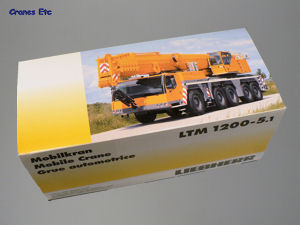 |
| Liebherr picture
sleeve. |
 |
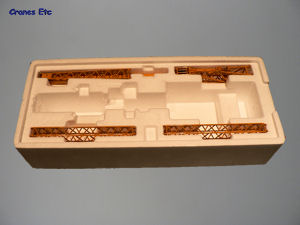 |
| Top half has the
fly jib sections. |
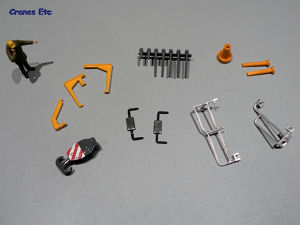 |
| The bags contain
the small items, but of course not the man. |
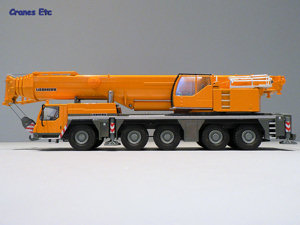 |
| Profile view. |
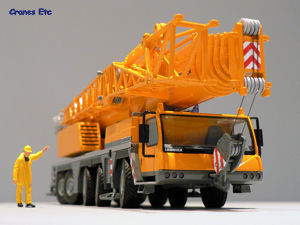 |
| 'Stand aside or
end up pancake style'. Plastic pulleys in the boom
head. |
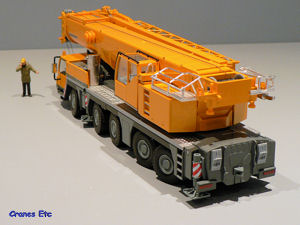 |
| Handrails on the
crane folded for transport mode. |
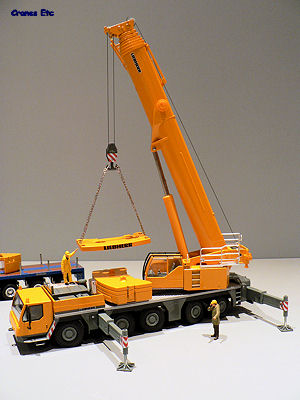 |
| Posing the crane
loading up the counterweight is a great display option.
|
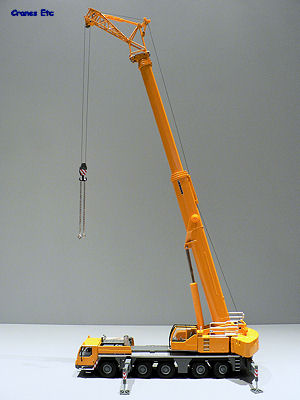 |
| Rigged with a short
erection fly jib. |
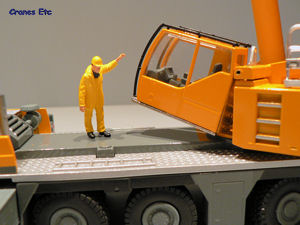 |
| Tilting cab for
the avoidance of operator neck ache. |
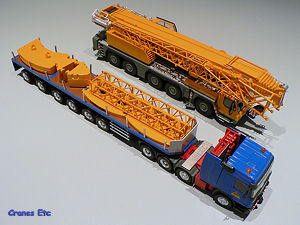 |
| Pair the crane
with a suitable ballast carrier and you get a terrific combination.
Here it is paired with a
Goldhofer Trailer.
|
|
The Liebherr LTM 1200-5.1 is a five
axle crane with a maximum load capacity of 200 tonnes.
The telescopic boom comprises of seven sections and can
reach 72m. A variety of combinations of fly jib up
to 43m long can extend the reach.
To see photos of the real crane, click
here.
Packaging
Initial impressions are that the box is satisfyingly heavy.
The model comes in the usual Liebherr picture sleeve which
surrounds a couple of expanded polystyrene trays.
It would have been better if the trays were marked 'top'
and 'bottom' to avoid being opened upside down. There
were no instructions provided with the initial release
of the model.
The model suffered no damage in transit. One of the
clip-on plastic handrails was poorly moulded but this was
quickly replaced by Conrad.
Detail
The underside of the carrier has almost no detail at all
with just the barest amount of chassis structure.
All five axles have the same plastic hubs meaning that the
central axle is not quite true to the original. Tyres
are the normal Conrad type and are fine.
At the front, the driving cab has the smooth lines of the
original. There are good headlights and a loop for
attaching the hook during transport. Other details
include orange beacon lights and clip-on plastic wing
mirrors. Behind the driving cab the exhaust stack,
tanks and other equipment are modelled well. The
carrier deck is patterned and there are a couple of
ladders detailed within the casting.
At the rear of the carrier the detailing is very good with
wheel chocks and a towing hitch as well as various panel
details within the casting. The rear light clusters
are painted on with all lights the same colour.
The crane cab is typically Conrad - effective but not laden
with detail. The grab rails are plastic and inside
the cab the controls and computer screen are modelled.
Behind the cab the casting of the body includes access steps
which lead up to a platform with plastic handrails which
clip on to the model. There are a couple of orange
beacon lights, an exhaust stack and another platform with
handrails. The counterweight consists of a variety
of separate plates which are pleasing castings and they
include lugs for lifting chains. There are two additional
triangular ballast blocks which slot into notches on the
slab. These look the part too, but sadly the lifting
lugs are not properly formed so it is not possible to properly
pose the model lifting these.
The main boom is lifted by a single large hydraulic
cylinder. Although the cylinder jacket is plastic the
colour match with the rest of the model is very good.
The boom is a seven section telescope with boom sections
in the 'oviform' shape of the original. A cable drum is
included on the side of the lowest boom section and
although this is a welcome addition of detail it is
marred by the plastic having a poor colour match. The
top of the first main boom section also includes a
working hoist rope guide frame. At the boom head
plastic pulleys are provided which are not the best
quality and are packed too tightly to turn freely.
The hook is a three sheave block with a double hook.
It is a pity that a second smaller hook was not provided
for use with certain configurations of the fly jib.
The fly jib consists of a number of pieces. The lattice
work sections are fine metal castings with the offset
mechanism being of plastic. The connecting method
is grey plastic pins and the fly jib connects to the main
boom using four short pins rather than the more usual two
long ones. When in transport mode, sections of the
fly jib rest on plastic brackets which the collector has
to attach to the main boom.
Features
The axles all steer and are linked together as a group of
three at the front and a pair at the back. Nearly all of the steering modes of the original crane can
be replicated including 'crab' steering where all wheels
point in the same direction to allow the crane to move sideways.
Outrigger beams are two stage so they can be set down in
different offsets and although they are all plastic they
are quite strong.
On the crane the operator's cab
tilts and the handrails on top of the crane body are foldable
to reduce the height of the vehicle when in transport mode.
All the usual crane functions can be operated. Raising
the main boom is a test of strength as the cylinder is very
stiff although on the plus side there is no expectation
of cylinder bleed and a drooping boom.
The counterweight mechanism works well on the model, replicating
the key hole method used by the original machine.
Although initial batches of the model were reported as having
a problem with the scaling in this area such that the counterweight
did not fit properly, there was no issue with the review
model. The separate slabs and cheek weights provided
give an excellent variety of display options.
Similarly the fly jib provides a large variety of
options with fifteen different configurations possible
in terms of length and offset angle.
Quality
This model is typical of Conrad. The miniature engineering
is excellent with a solid robust model the result.
In terms of detail it is not to the highest modern standards
but does represent a gradual improvement by Conrad rather
than a dramatic addition of detail compared to earlier models.
The quality of the casting and paintwork is very high.
Price
It is very good value compared to other 5 axle mobile cranes
being produced at the time of the review.
Overall
This is a great crane model for experienced or new collectors
alike. It has a huge range of display possibilities
as result of the sectional counterweight and fly jib, and
looks great in transport mode particularly if accompanied
by a ballast carrier.
There are a few areas where improvements would improve
the model. Some instructions and
a data sheet would be helpful and a little more attention
on some of the details would have been appreciated by collectors.
Later versions of the model included improvements. Overall though, there is no question that this is a recommended
model.
Footnotes
The model first appeared at retailers at the end of
2006. Early models had a problem reported with the
counterweight fixing. This was amended for later models. An instruction leaflet was produced
for the model and appeared for download from the Conrad
website in February 2008:
instructions.
It has been produced in a variety of liveries.
In September 2007 a limited edition of 1000 models in
Mammoet colours was produced. In April 2012
versions commissioned by Heavy Transport Models appeared in
Kanson and
H N Krane livery.
|
|
|
|
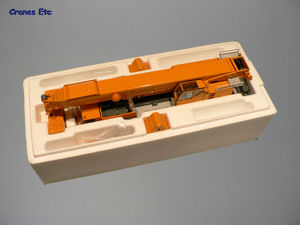 |
| Sitting nice and
warm in the box. |
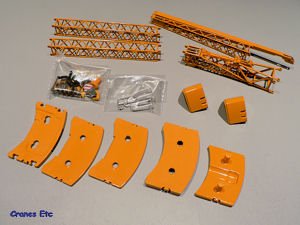 |
| Out of the box
there are quite a few pieces. |
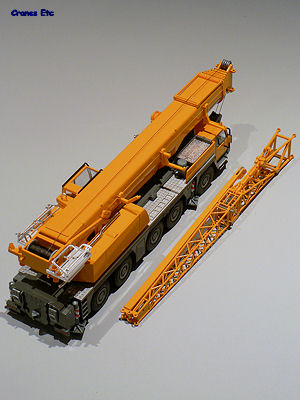 |
| Photo shows which
fly jib supports go in which place on the main boom.
|
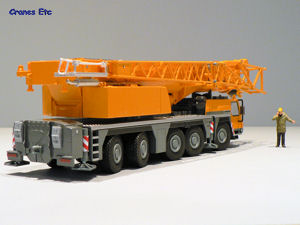 |
| Wheel chocks and
towing hitch at the rear. |
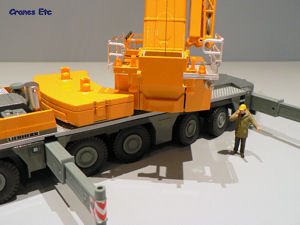 |
| Counterweight slabs
sit well on the carrier deck. Click above to get the large
photo and see the 'key-hole' connecting system for picking
up the counterweight. |
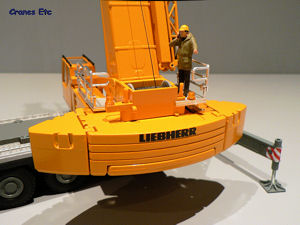 |
| A full counterweight
setup including the cheek weights. Foldable handrails
opened up. |
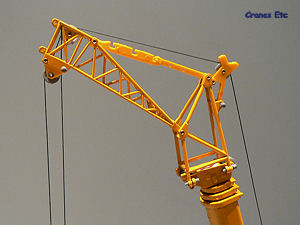 |
| Close up of the
offset mechanism. |
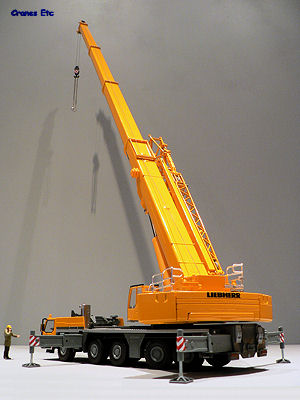 |
| Crane looks dramatic
when raised and there are still another three telescope
sections to go. |
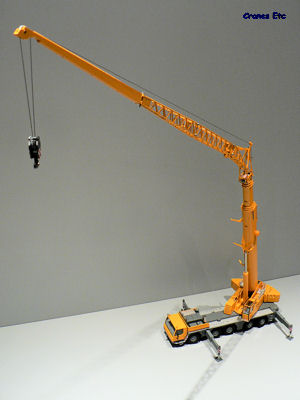 |
| Fly jib attached.
Big, and there is still another lattice section not fitted
in this pose. |
|

